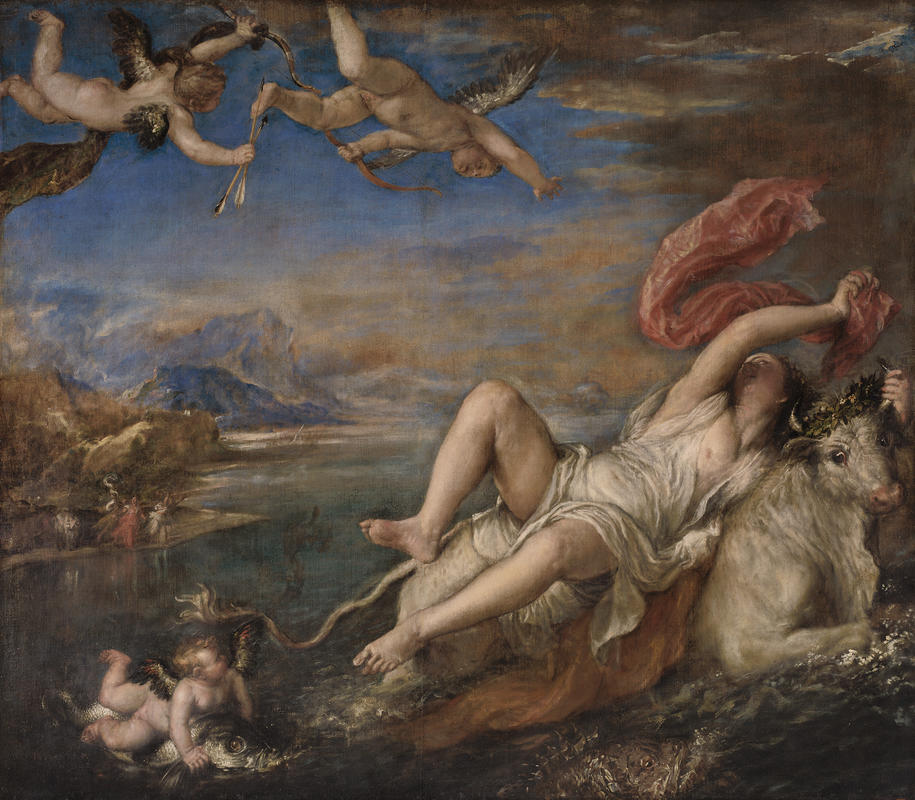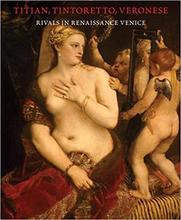More about The Rape of Europa
- All
- Info
- Shop

Sr. Contributor
In the story of Europa, Jupiter once again shows that he’s not afraid to get freaky, but honestly, what else is new?
Jupiter, known to the Greeks as Zeus, was the king of the ancient pantheon of gods, reigning high on Mount Olympus. As king, Jupiter was free to do whatever (and whoever) he wanted. And if you had the same freedom, you’d probably try to bang everything in sight, too. There are countless stories of Jupiter shape-shifting to get it on with the various people and creatures of the ancient world. In the process, he took on the form of a swan, a shower of golden coins, and even the goddess Diana, among others. Jupiter was getting busy with everyone and everything, so it’s really no surprise that he would also transform himself into a bull to add the princess Europa to his staggering list.
The story, which comes from Ovid’s Metamorphoses, describes how Jupiter saw the beautiful Europa walking with some friends on the shore of a beach. Having to mask his true identity, he appeared to the group of young women as a white bull. Although her friends were scared and probably like WTF, Europa was not afraid. Instead of walking away like a normal person, she offered the bull some flowers and even sat upon his back. Cozy, much? One can only hope that Europa’s friends would not do an equally terrible job of helping her dodge a creepy dude in the club, but who knows? Anyway, as Europa got on Jupiter’s back, he promptly whisked her away to the island of Crete to consummate his love for her (rape her).
Unfortunately, rape was a pretty popular mythological topic, and it pops up in many of the stories, especially those about Jupiter/Zeus. Although many artists like Rembrandt changed the name of the story to The Abduction of Europa, Ovid’s tales usually end with something sexual. But Europa’s story actually has a fortuitous ending. Jupiter impregnated Europa, and their son went on to become King Minos of Crete. And despite being the guy who fed Athenian children to a minotaur who lived in a labyrinth, Minos also founded ancient Greek civilization and therefore initiated the rise of Europe. Europe...Europa….get it?
Keeping this connection to Europe in mind, it’s easy to imagine the mythological roots of the continent and its great civilizations. It’s also easy to imagine why a powerful member of the European royalty would commission Titian to paint mythological subjects. King Philip II of Spain owned thirty Titian paintings. Six of these works – Europa and five others – became known as the “poesie” because Titian thought of them as visual poetry. Calm down, Titian.
King Philip left Titian free to his own devices, allowing the artist to choose stories that he thought the king would like best. After the rediscovery of the ancient world during the Renaissance, people became obsessed with antiquity and mythology. Ovid’s love stories – if you can call the rape of an unsuspecting young princess love – became one of the central, decorative motifs for royal palaces. Naturally, King Philip II of Spain wanted art that told stories that were fit for a king, and comparing the king to Jupiter stroked his ego just right. Yeah, that’s the spot.
Sources
- Department of European Paintings. “The Rediscovery of Classical Antiquity.” The Heilbrunn Timeline of Art History. The Metropolitan Museum of Art. October 2002. http://www.metmuseum.org/toah/hd/clan/hd_clan.htm. Accessed August 1, 2017.
- Department of European Paintings. “Titian (ca. 1485/90–1576.” The Heilbrunn Timeline of Art History. The Metropolitan Museum of Art. October 2003. http://www.metmuseum.org/toah/hd/tita/hd_tita.htm. Accessed August 1, 2017.
- Hartt, Frederick, and David G. Wilkins. History of Italian Renaissance Art: Painting, Sculpture, Architecture. 6th edition, Upper Saddle River, NJ: Prentice Hall, 2007.
- Isabella Stewart Gardner Museum. Europa. Collection. http://www.gardnermuseum.org/collection/artwork/3rd_floor/titian_room/e…. Accessed August 1, 2017.
- Kline, A.S. Metamorphoses. Book II. 833-875, http://ovid.lib.virginia.edu/trans/Metamorph2.htm#476707521. Accessed August 2, 2017.
- The National Gallery. “Poesie for Philip II.” Titian’s ‘poesie’ paintings. Paintings. http://www.nationalgallery.org.uk/paintings/learn-about-art/titian-s-po…. Accessed August 2, 2017.
- Thompson, Wendy. “Lovers in Italian Mythological Prints.” The Heilbrunn Timeline of Art History. The Metropolitan Museum of Art. October 2004. http://www.metmuseum.org/toah/hd/lovr/hd_lovr.htm. Accessed August 1, 2017.
Featured Content
Here is what Wikipedia says about The Rape of Europa (Titian)
The Rape of Europa is a painting by the Venetian artist Titian, painted c. 1560–1562. It is in the permanent collection of the Isabella Stewart Gardner Museum, in Boston. The oil-on-canvas painting measures 178 by 205 centimetres (70 in × 81 in).
Check out the full Wikipedia article about The Rape of Europa (Titian)













